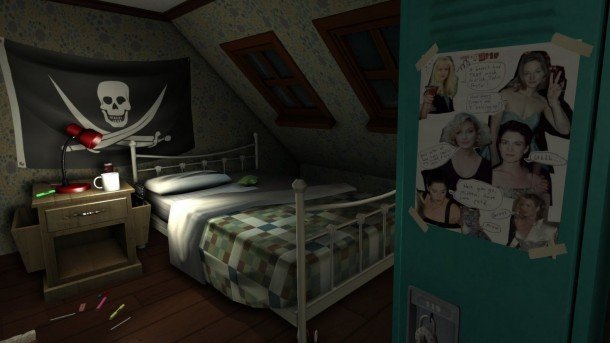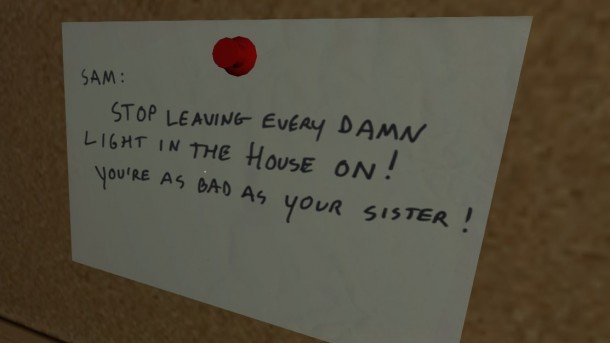The making of Gone Home

“The reason that we could go a year and a half from - let's try downloading Unity to 'we have reviews of the game up online',” Steve says, “Is because we came up with a very small well-scoped plan early and then we just did it, and we didn't run into anything where we lost four months of work or anything else. There was a lot of luck to that, we are insanely lucky that we found Kate Craig who did our 3D art, because a month or two after we started on the project we happened to meet her, she just happened to be a 3D artist and she happened to be interested on working on something new."
Fullbright's lean development management is also reflected in Gone Home's design, as Steve explains. “I think that what we did is take games that did have established frameworks that we had worked on before, we were reductive about it and we removed elements until we had as little as we needed to get this experience across, then we added very little back in to specifically support what we were doing.
"For the most part it was like 'we know this genre of exploratory FPS games, if we scale back as far as possible and then add in as little as possible to mould what we are doing to that specific end…' That was the process that we had, which I think is an interesting middle ground between 'okay we're just going to take an established genre do that thing everybody knows what it is,' and 'let's start from scratch and assume nothing and be as experimental as possible.'“

Taking an established way of looking at games led to the team being extremely puckish with game-literate players. At one point you see a bath slathered in red; you can't help but think the worst.“People think they've seen this kind of thing, 'when they did this last there was a monster,' It's normal to make those associations,” Karla says. “[It wasn't] 'haha you thought we were going to do this, you're an idiot.'”
“It wasn't pulling a prank on the player,” Steve says. “The intent on my end was what you're pointing out is that in a game there's going to be something unreal or fantastical about the setting – because there might as well be. If you can have your game and have your ghosts and zombies in it. That's something that's expected."
"Your assumption is that there's going to be some kind of crazy thing – a monster in a closet or something."
At another juncture the Greenbriar parents have left a Post-It note admonishing the youngest sister Samantha for leaving all the lights on in the house - something that you as a player have been doing ever since you started the game. Gone Home plays with the idea of 'unreality' in games, pointedly telling the player they are here for the characters and their experience of a world that the players are familiar with. Our own.
“It is weird, in a game you don't start with the assumption that this is a normal real world,” Steve argues, “and then there's something weird and it's like 'woah that's crazy.' But if you're reading a book and there's ghosts in it, your standard expectation of this isn't about people - it's changed to a genre book. But with games you come from the expectation of, if you see blood then there's probably a serial killer, if it seems haunted then it probably is. So from my point of view we had to do real work to reinforce the idea that no this is just the real world where normal people live and there is nothing in this fiction that wouldn't be in our own reality.
Keep up to date with the most important stories and the best deals, as picked by the PC Gamer team.
“Your very assumption is that there's going to be some kind of crazy thing – a monster in a closet or something. For me I wanted to keep pulling that imagery and whenever that imagery put on screen to saying 'no it's just something normal that can happen in anybody's house, this is the real world.' Hopefully by the end you're concentrating on the story of these characters you're learning about and not 'oh it's now the ghost is going to jump out on me'.”

Due to the stringent descoping of the Gone Home team on anything that wasn't strictly necessary, there were so few problems in development that Karla has to tell me about the time she tried to put a skeleton in a pillow. “You know when you drop a pillow on the floor and you expect it to scrunch,” Karla says, musing on pillow poofiness. “We thought we could see if we could make ragdoll physics for the pillows. We needed to have ragdoll with Unity, we tried to do it and it didn't work multiple times, and I thought 'I have no idea what I'm doing,' I talked to a guy at Unity and he said 'you can't do ragdoll that aren't humans!' So I tried to put a human skeleton inside a pillow, it was weird, but that also didn't work. So we were like 'okay we're not going to have squishy pillows.'”
"I tried to put a human skeleton inside a pillow, it was weird."
But working in the Gone Home house - wasn't it hard, living with your workmates? Seeing them every day?
“Well I totally want to be like 'well not once we all took the medication, then it was fine!'” Karla laughs. “I don't think we had any major issues. I think we were all pretty grown up about it, because we are grownups and we've had roommates before and stuff. I like having roommates because I tend to be a creepy hermit because it's nice to be around people who do things who you can talk to. So you don't get up one morning and think 'I haven't spoken to a human being in five days'. I don't think we had any problems.”
And so what was a day in development like?
“It's a lot of working in parallel,” Steve says. “Each of us had our area and responsibilities that were well compartmentalised from everybody else's. I, being the level designer, had to touch all of it, my work was clearing what everybody else was putting into the game. I ended up knowing what notes Karla had finished that were ready to put in the game, and I had to know what 3D meshes Kate had done, I needed to know what stage the system was working in so I could start using it and so on and so forth. “
“Our jobs had way more variety. We were very seldom stuck for weeks working on the same thing. Even if it was like 'press event, let's work towards that.' It's really valuable to be able to do that, rather than 'we have you down for 200 assets, which number are you on now?'” Karla adds.
Read on for discussion of Gone Home's ending. If you haven't finished the game, stop reading, there be huge spoilers ahead .

